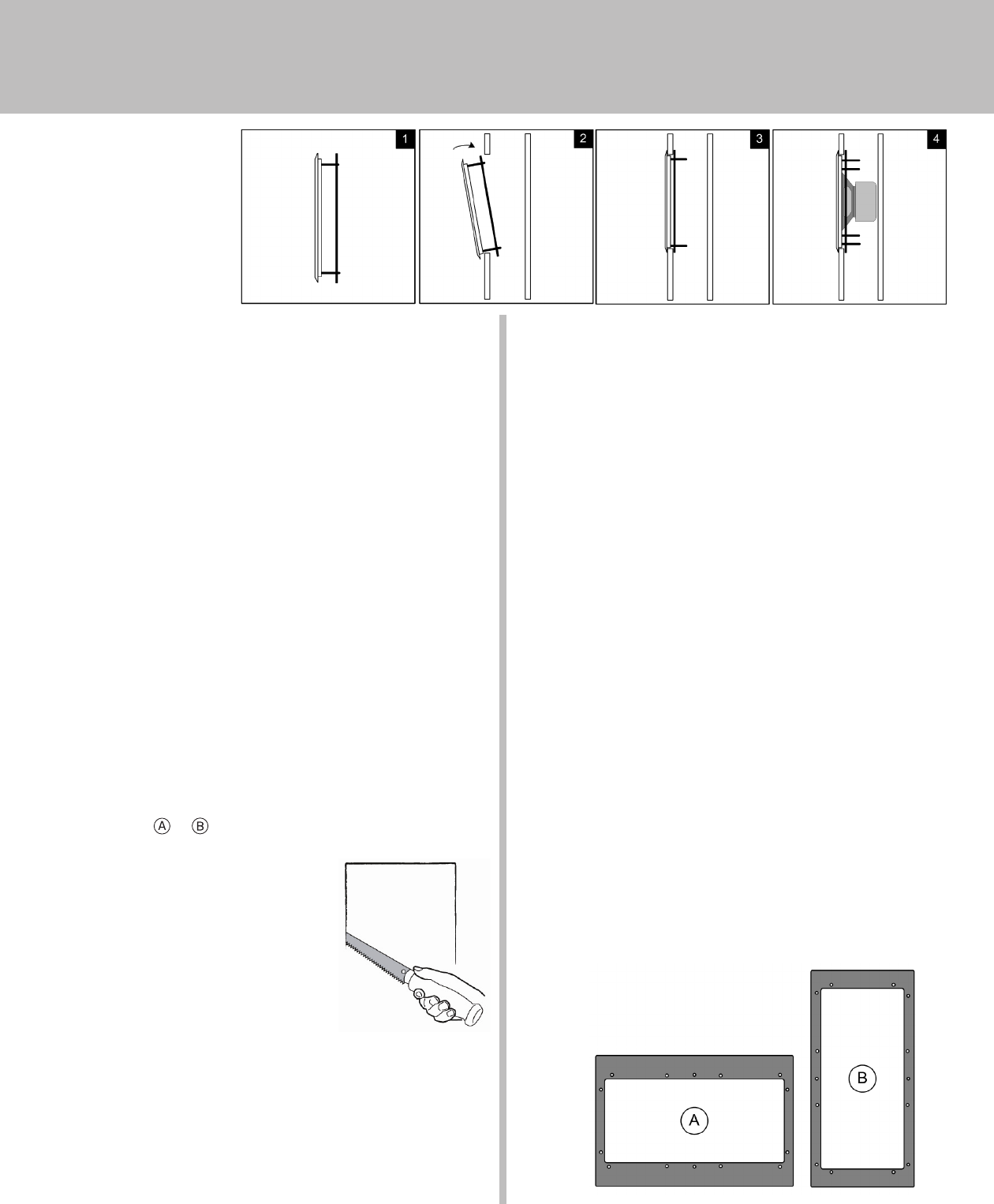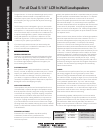
For all Dual 5-1/4" In-Wall Loudspeakers
page 2 of 2Rev. A
entering the back of the speaker. This can be accomplished by
placing a batt of berglass insulation over the back of the speaker.
As the diagrams show, the speakers utilize a metal mounting ring
which, after tightening with the screws provided, acts as a clamp
to hold the speakers in place.
Install the frame and mounting ring assembly by passing the black
mounting ring through the cut-out as illustrated in gures 1 & 2.
The white frame should t cleanly, without interference, in the cut-
out hole. If the hole is a little small then trim the hole as needed.
Lightly tighten the screws to secure the clamp ring against back
of the wall. (see g. 3) Use care not to over-tighten the screws or
the frame will become distorted and make it difcult to install the
grille.
Pull the end of the cable out of the wall, strip back a section of the
jacket as needed, and then expose ½" (13mm) of each conductor.
Connect the wire to the terminals on the back of the speaker
assembly, observing polarity (+ & -).
Insert the speaker into the frame and install the eight screws.
Tighten the screws beginning with the four inner screws followed
by the four outer. (see g. 4) Use care not to over-tighten the
screws or it may later become difcult to install the grille. Install
the grilles after testing the operation of the speakers. The grilles
are installed by gently working the edge of the grille into the frame
of the speaker, beginning at one corner and working one or both
directions around to an adjacent or opposite corner.
If the speaker frames are to be painted after installation, either
remove the speaker bafe assembly or use the paint-mask (the
inner cardboard rectangle) to cover the speakers to prevent
damage. DO NOT PAINT THE GRILLE AND
FRAME ASSEMBLY TOGETHER. The grille
should be painted separately. Use thin coats
and thin the paint as necessary to avoid
clogging the perforations with excessive
paint.
If connecting more
than two speakers to
one amplier channel
we suggest that you
consult a professional for
assistance.
When connecting your
speakers, make sure
proper polarity (phasing) is maintained. Simply put, this means
ensuring the same wire which is connected to the positive
terminal of the amplier has its other end connected to the
positive terminal of the speaker. Note: Most manufacturers use
red to designate +. If the connections on one of the speakers are
reversed, (out of phase) the quality of your bass will be seriously
impaired.
INSTALLATION
If the drywall has not yet been installed a Rough-in-Bracket (RIB-
LCR) may be used to reserve the speaker location on the wall.
The RIB-LCR brackets are available from the distributor or dealer
where the speakers were purchased. When the brackets are used
the holes are cut when the drywall is installed. The cable can be
tied off on the bracket after securing the cable to a nearby joist.
If the drywall is installed and the speaker locations have not yet
been established then do so now. Assess the wall for possible
concealed obstructions such as wiring, plumbing, etc. Inspect the
backside of the wall, the attic, and/or the crawl space if available
for clues to possible obstructions. Use inspection holes with
inspection tools (camera, mirror, ashlight, etc.) if absolutely
necessary. Use a “stud nder” to locate the positions of the studs.
All the speakers are shipped with two different style clamp rings
that allow the speaker to be installed immediately next to a
stud—items
& below.
Once the speaker locations are established
use the paper template (the outside of
the outer cardboard rectangle) to mark
the speaker cut-out. The dimensions for
the cut-out are listed in the chart on the
previous page. Using the proper tool, cut
the appropriate sized hole in the wall. On
drywall, clean cuts can be made with a
drywall saw.
If the cable has not yet been run, do so now
that you have access to the wall’s interior.
To aid in speaker performance, a brous material, such as
berglass or polyester ber, may be placed behind the speaker.
This may also help to reduce unwanted sound from being
transmitted into adjoining rooms. If the wall space has blown
or loose insulation, it is important to prevent the insulation from




